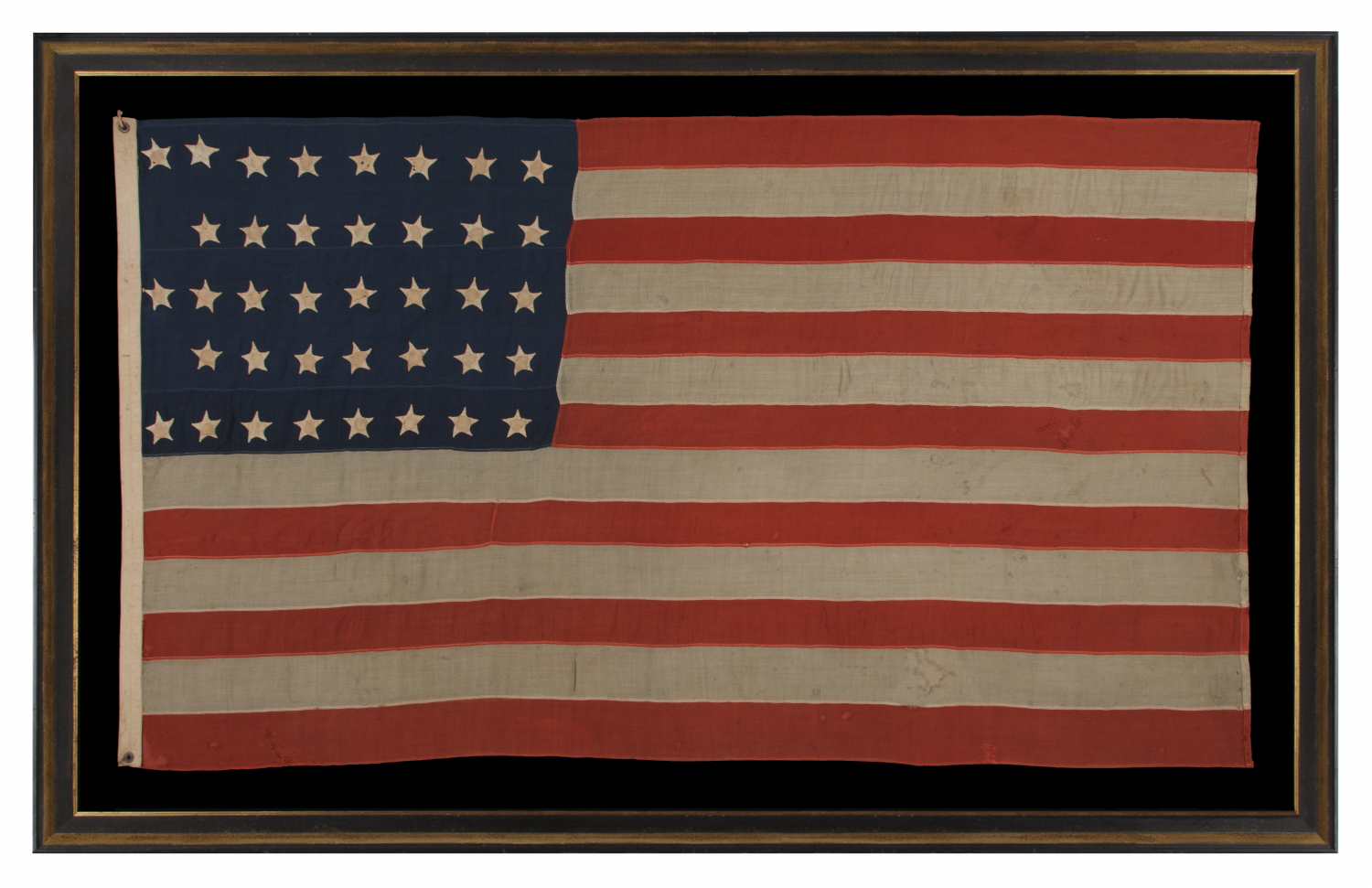
| |
38 HAND-SEWN STARS IN A "NOTCHED" PATTERN ON AN ANTIQUE AMERICAN FLAG MADE AT THE TIME WHEN COLORADO WAS THE MOST RECENT STATE TO JOIN THE UNION, 1876-1889 |
|
| Available: |
In Stock |
| Frame Size (H x L): |
Approx. 62.5" x 100" |
| Flag Size (H x L): |
49.75" x 87.25" |
|
| Description....: |
|
38 star American national flag with nice presentation, large scale, and interesting features. The stars of the flag are hand-sewn, made of cotton, and are double-appliquéd (applied to both sides). These are configured in what is known as a "notched" pattern, in which two spaces were left open along the hoist end, in anticipation of the addition of two more Western Territories. The latter 19th century was a time when much of the land in and about the Continental Divide was formalized into states.
The canton and stripes of the flag are made of wool bunting that has been pieced with treadle stitching. The canton was constructed of three lengths of fabric. Because blue wool bunting was available in a maximum width of 18 inches, this was a necessity in flags that had a canton larger than that this in height. Note how the 5th red stripe was pieced in two sections, as a means of efficient use of available fabric. There is a heavy canvas binding along the hoist with two brass grommets. A small length of knotted hemp rope is present in the top grommet--a remnant of its use in the period.
Colorado became the 38th state on August 1st, 1876. This was the year of our nation’s 100-year anniversary of independence. Per the Third Flag Act of 1818, stars were not officially added until the 4th of July following a state's addition. For this reason, 37 was the official star count for the American flag in 1876. Flag-making was a competitive venture, however, and few flag-makers would have been continuing to produce 37 star flags when their competitors were making 38’s. It is for this reason that 38 and 13 stars (to represent the original 13 colonies) are more often seen at the Centennial International Exposition, the six-month long World’s Fair held in Philadelphia in honor of the event. Some flag-makers would have been adding a star for the 38th state even before it entered the Union, in the early part of 1876 or even prior. In fact, many makers of parade flags were actually producing 39 star flags, in hopeful anticipation of the addition of two more Western Territories instead of one. But the 39th state would not join the Union for another 13 years, when the Dakota Territory entered as two states (numbers 39 and 40) on the same day, on November 2nd, 1889.
Note: While a notation along the hoist binding reads "8 feet" in penciled script, the flag actually measures 7'3" on the fly x approximately 4'2" on the hoist. Since 4 x 7 feet is a typical proportion I would expect to encounter on a flag of this era, and since the stitching of the binding along the fly end appears to be original, I expect that the notation might relate to pre-cut fabric for hoist bindings, as opposed to size of the finished flag. While it is possible that the flag may have been turned back and professionally re-bound as a proper means of extending its term of use, the flag does not seem to exhibit the commensurate level of wear elsewhere and this does not seem to be the case.
Mounting: The flag was mounted and framed within our own conservation department, which is led by expert trained staff. We take great care in the mounting and preservation of flags and have framed thousands of examples.
The background is 100% cotton twill, black in color. The black-painted, hand-gilded and distressed molding is Italian. The glazing is U.V. protective plexiglass. Feel free to contact us for more details.
Condition: There is some water staining and soiling of the white cotton and canvas, as well as in the white wool stripes. There is minor wear with associated loss in the upper and lower hoist end corners, accompanied by moderate areas of loss in the 4th red stripe and the 6th white stripe and modest to minor losses elsewhere. There is a diagonal tear in the last red stripe, near the hoist end, and there is a darning repair in the same stripe, about 1/5th of the way back from the fly end. Fabric of similar coloration was placed behind the flag for masking purposes, during the mounting process. Many of my clients prefer early flags to show their age and history of use. |
|
|
|
| Collector Level: |
Intermediate-Level Collectors and Special Gifts |
|
| Flag Type: |
Sewn flag |
|
| Star Count: |
38 |
|
| Earliest Date of Origin: |
1876 |
|
| Latest Date of Origin: |
1889 |
|
| State/Affiliation: |
Colorado |
|
| War Association: |
1866-1890 Indian Wars |
|
| Price: |
SOLD |
|
| |
Views: 96 |
|
|
|

